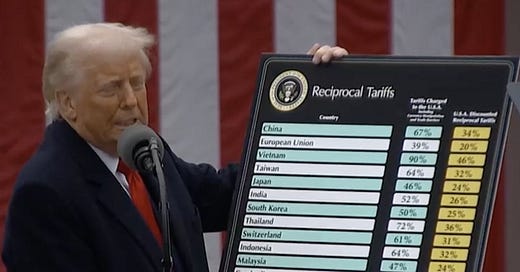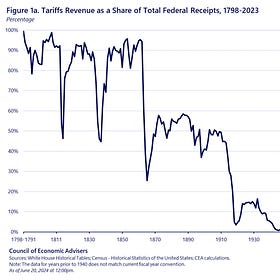Thanks for reading America Explained. If you haven’t already, please consider upgrading to a paid subscription. This will enable you to read all of this post and access the full archive. It will also enable me to put more time and energy into this newsletter, something that I’m hoping to do in order to cover the new administration more thoroughly. If you’re already a paid subscriber, thanks for supporting independent media and making it possible to do what I do.
Donald Trump just announced his ‘Liberation Day’ tariffs, and it’s pretty much the worst case scenario imaginable.
Although we knew there was a big trade move coming today, it wasn’t really clear what he was going to announce. Financial markets seem to have gotten complacent in the hours before the announcement, assuming things wouldn’t be that bad. Then Trump got this chart out.
What this chart ostensibly shows is the tariffs that a country imposes on trade with the U.S. (the middle column) and the new tariff rate that the U.S. will impose on it (the right column). The numbers in the right hand column are extremely high. This is no longer just a question of whether high tariffs will cause some inflation in the United States. It’s a question of whether the stock market will see a major correction and the global economy will be flung into a depression.
During his rambling speech, Trump actually made reference to the history of the Great Depression. Or rather, he made reference to some fictional alternative history of the Great Depression in which it would “never have happened” if the U.S. had “stuck with” having high tariffs, as it did in the nineteenth century. This is completely insane - everyone agrees that the Great Depression was made much worse by the infamous Smoot-Hawley tariff act and the response of other nations to it.
Trump just announced a Smoot-Hawley all of his own, and like its predecessor, it has the potential to cripple the American and global economies. Tariffs are essentially a huge tax hike, making businesses unprofitable and consumers poorer. And it’s not clear that Trump is doing this just because of some desire to “negotiate” - he’s been talking a lot lately about using tariffs as a structural, long-term way to reshape the economy and raise government revenue.
During his speech, he even took a shot at income taxes, saying that nobody knows why the U.S. moved from funding the federal government through tariffs to funding it through income taxes. Actually, everybody does know why, and I wrote about it here last year. The short version is that tariffs can’t possibly raise enough money to be a major source of government revenue, that any attempt to make them so will destroy the economy, and that they disproportionately harm the poor in a massive way.
Another problem is that the numbers in the middle column of Trump’s chart seem completely made up - whatever they are, they’re not the tariff rate that the country in question imposes on the U.S. It seems that the administration has also thrown a lot of non-tariff stuff into the mix, for instance counting sales taxes as a tariff even though those are also imposed on domestic producers. This matters because it means that in a lot of cases, these aren’t even things that the countries involved can negotiate over. For instance, unless Trump is proposing that the European Union eliminates its sales tax, there’s not a lot it can do about a huge chunk of what he is counting as its “tariffs”.
This is the consequence of handing unfettered power to a deeply stupid and economically illiterate person. The question now is whether he can be stopped. Fortunately, Trump seems to be moving so quickly and so decisively that he is going to create a huge amount of opposition. He waited until after the U.S. stock market closed to make his announcement, but the reaction in other markets seems to be a complete bloodbath.
And this brings home a really important point: if Trump really is trying to institute fascism, he’s doing it in a very stupid way. Fascists understood that they needed to bring the economic elite along with them, even if it was in a cowed fashion. There was a path open to Trump to steadily erode U.S. democracy while keeping Wall Street sweet with cuts to taxes and regulation. He chose not to take that path, because he’s a Tariff Man. It may just be the greatest gift he has ever given to his enemies.
Thanks for reading America Explained. If you haven’t already, please consider upgrading to a paid subscription. This will enable you to read all of this post and access the full archive. It will also enable me to put more time and energy into this newsletter, something that I’m hoping to do in order to cover the new administration more thoroughly. If you’re already a paid subscriber, thanks for supporting independent media and making it possible to do what I do.
More from America Explained:
On tariffs, Trump resurrects 18th century economics
Trump has a profoundly incorrect view of the role that tariffs can play in the economy.






Thank you for your clarity and common sense explanation to the President's rollout of these tariffs.
Well done.